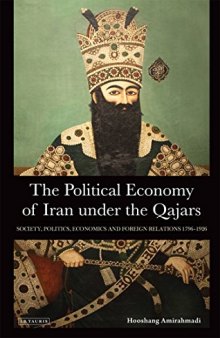 جزییات کتاب
جزییات کتاب
The political economy of Iran underwent the fundamental transition from feudalism to modernity from the early 19th to the 20th century: a period which was a vital watershed in Iran's historical development. This book provides a critical analysis of Iran's economic, social, and political development and shows how the path to modernity, far from smooth, was hindered by both internal and international factors. These included a powerful monarchy with little interest in administrative and economic reform, a large aristocracy frequently holding vital provincial governorships and frustrating effective central government and a failure to create a modern civil service, military, banking, finance, or communications - the essential infrastructure for economic development. Reformers were marginalized and business suffered. And the all-powerful ulema were a further brake on modernization. On the international front, the rivalry of Britain and Russia compounded the problems: both acting to control Iran and to further their own interests.Hooshang Amirahmadi explores the roots of present-day challenges to modernization and progress and, using a wealth of primary sources and original research, has produced a work which is invaluable for students of modern Iranian history, politics, and Iran's political economy
 درباره نویسنده
درباره نویسنده

هوشنگ امیراحمدی (متولد ۱۳۲۶، شاندرمن) از دانشگاهیان و تحلیلگران سیاسی ایرانی آمریکایی است. او استاد دانشگاه راتگرز (دانشگاه ایالتی نیوجرسی) و مدیر مرکز مطالعات خاورمیانه این دانشگاه است.
 دانلود کتاب
دانلود کتاب
 جزییات کتاب
جزییات کتاب
 درباره نویسنده
درباره نویسنده
 هوشنگ امیراحمدی (متولد ۱۳۲۶، شاندرمن) از دانشگاهیان و تحلیلگران سیاسی ایرانی آمریکایی است. او استاد دانشگاه راتگرز (دانشگاه ایالتی نیوجرسی) و مدیر مرکز مطالعات خاورمیانه این دانشگاه است.
هوشنگ امیراحمدی (متولد ۱۳۲۶، شاندرمن) از دانشگاهیان و تحلیلگران سیاسی ایرانی آمریکایی است. او استاد دانشگاه راتگرز (دانشگاه ایالتی نیوجرسی) و مدیر مرکز مطالعات خاورمیانه این دانشگاه است. 








 این کتاب رو مطالعه کردید؟ نظر شما چیست؟
این کتاب رو مطالعه کردید؟ نظر شما چیست؟
